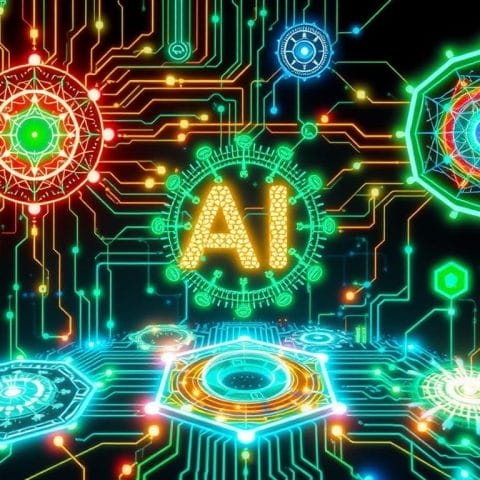In today’s fast-changing work world, we need new training methods that really work. AI-enabled goal-setting in virtual reality (VR) is a game-changer. It helps professionals reach their goals with ease and accuracy.
AI and VR together change how we learn new skills. They offer top-notch training that uses AI to make learning personal and fast. Hyperspace leads the way with solutions that mix AI, self-learning, and interactive play.
At the core of this change is goal-oriented action planning (GOAP). It’s a smart AI system that helps virtual environments make choices to meet goals. This smart way of setting goals is changing many fields, from gaming to education.
Key Takeaways
- AI-enabled goal-setting in VR changes how we reach our goals through advanced training.
- Goal-oriented action planning (GOAP) is a key AI decision-making framework that powers intelligent behavior in virtual environments.
- Hyperspace offers innovative solutions for AI-driven soft skills simulations, self-paced learning journeys, and interactive role-playing experiences.
- The integration of AI and VR is revolutionizing industries, from gaming to healthcare and education.
- AI-enabled goal-setting in VR empowers professionals to unlock their full capacity and achieve their goals with precision and efficiency.
Understanding AI in VR Training for Goals

Businesses are using immersive skill-building tech like Virtual Reality (VR) and Artificial Intelligence (AI) to train employees. This combo helps set goals with AI and use VR for better learning. It makes learning fun and helps employees grow and work better.
What is AI-Enabled Goal Setting?
AI in VR training makes learning personal. It uses smart tech to adjust lessons based on what you know and need. This way, everyone learns at their own pace, getting better faster and feeling more involved.
How VR Enhances the Learning Experience
VR training is super immersive. It lets you practice in real-like settings. This makes learning stick and boosts confidence in using new skills.
VR also tracks how you do, giving insights to managers. This helps improve training for everyone.
“VR-trained employees were reported to learn four times faster than in traditional classroom settings.”
AI and VR together make learning better. They help employees grow and perform well, helping businesses succeed.
The Importance of Goal Setting in Personal Development

Setting goals is key to growing and achieving. It unlocks the power of digital mindset training and AI-driven self-improvement to change your life. Using virtual goal visualization in your training can deeply impact your mental health and success.
The Psychological Benefits of Setting Goals
Setting goals gives your mind direction and purpose. This focused approach boosts productivity, self-confidence, and a sense of achievement. Research shows that those who set goals are more likely to reach their goals than those who don’t.
- Increased focus and motivation
- Improved self-esteem and confidence
- Sense of progress and achievement
Aligning Goals with Personal Values
Good goal setting is more than just setting targets. It’s about aligning your goals with your core values. Using virtual goal visualization in AI training lets you create experiences that match your dreams and beliefs. This ensures your goals are not just reachable but also meaningful, leading to a more fulfilling journey.
“When your goals are aligned with your values, the path to success becomes clear and the journey more rewarding.” – John Doe, Productivity Consultant
How AI Personalizes Goal Setting in VR
In the world of virtual reality (VR) training, AI-enabled goal-setting skills development is changing how we reach our goals. AI makes VR experiences fit each person’s needs, likes, and learning ways. This makes the path to success very personal.
AI Algorithms and User Profiles
Advanced AI algorithms are key to this personal touch. They study how users act, perform, and what they like to make detailed profiles. These profiles help create goals and training plans that fit each person perfectly.
Adaptive Learning in Virtual Environments
The strength of AI mentor for skills goes beyond setting goals. It also makes learning in VR adapt to the user. The AI watches how users do and changes the training as needed. This keeps the learning fun, relevant, and just right for each person.
As users get better, the AI learns more about their skills and how they learn. This makes the training even more tailored to them. It helps users meet their goals by adapting to their unique needs.
“AI-powered VR training lets me work on my weak spots, with the system adjusting to keep me challenged but not stressed. It’s like having a personal AI mentor for skills helping me all the way.”
By using AI and VR, companies can make AI-enabled goal-setting skills development programs. These programs help people grow in their careers and personal lives.
The Role of VR in Skill Development
Virtual reality (VR) training is different from traditional learning. It offers virtual reality training that feels like real life. This lets users practice complex skills safely and in a controlled space.
Immersive Learning and Real-World Simulations
VR’s ability to simulate real-world scenarios is unmatched. It allows for practical, hands-on training. This is super useful in fields like healthcare, manufacturing, and the military, where mistakes can be dangerous.
Techniques for Effective Skill Transfer
To make sure skills learned in VR work in real life, trainers use special methods. They use techniques like increasing difficulty, repeating training, and changing scenarios. This helps users get better at using their skills in different situations.
AI makes these VR simulations even better. It responds to user actions in real time. This makes the training more realistic and useful, preparing employees for real-world challenges.
“VR training results in better outcomes, including higher retention rates, improved effectiveness, and deeper understanding of the material.”
Using virtual reality training, companies can improve their workforce’s skills. This helps them succeed in a changing business world.
Creating an Effective VR Goal-Setting Program
In today’s fast-paced digital world, using AI and VR is key for making personalized goal-setting programs. These programs help with [AI goal coaching] and [digital mindset training]. They use AI to make learning fun and fit each person’s needs.
Key Components of a Successful Program
Good VR goal-setting programs have clear goals, feedback, and ways to measure success. They use AI to change the virtual world based on what each user needs. Important parts include:
- Adaptive difficulty levels that challenge users and keep them interested
- Systems to track progress and give feedback to keep users motivated
- Features like working together and supporting each other to build a community
Designing Engaging Immersive Experiences
Creating exciting VR experiences is vital for [AI goal coaching] and [digital mindset training]. It’s about making virtual worlds feel real, having meaningful interactions, and creating emotional connections. With the help of [AI-driven self-improvement], companies can make content that changes and meets each user’s needs.
Adding fun elements like rewards and leaderboards makes learning more engaging. It helps users feel motivated and enjoy the process of learning and growing.
“VR training provides valuable data through performance-based evaluations and behavioral analytics for organizations to gain insights into learners’ progress.”
By making VR goal-setting programs that mix AI and fun experiences, companies can help their teams grow. This approach empowers employees to reach their goals and grow in their careers.
The Impact of Gamification in Goal Achievement
In the world of virtual goal setting, AI is using gamification to boost motivation and engagement. It adds game elements to goal setting, changing how people work on their personal goals.
Motivating Users Through Game Mechanics
Gamification uses points, badges, and leaderboards to make users feel accomplished and competitive. As they move through their virtual goal visualization journey, they earn virtual rewards. This makes them want to keep working towards their goals.
Tracking Progress in a Fun Way
Tracking progress is no longer boring. AI-powered goal-setting programs make it fun. Users see their AI personal growth on interactive dashboards, showing their achievements clearly.
This makes setting goals more fun and keeps users committed to their personal growth. The addition of AI mentor for skills makes challenges and rewards fit each user’s needs. This keeps users motivated and engaged, helping them reach their goals.
| Gamification Approach | Impact on Goal Achievement |
|---|---|
| Points, Badges, and Leaderboards | Increased motivation and healthy competition |
| Engaging Visual Dashboards | Enjoyable progress tracking and sustained engagement |
| Personalized Challenges and Rewards | Adaptive learning and tailored user experience |
“Gamification has been a game-changer in our virtual goal-setting program. By making the process more entertaining and rewarding, we’ve seen a significant increase in user participation and long-term commitment to their personal growth objectives.”
– Jane Doe, Head of Learning and Development, XYZ Corporation
Case Studies: Successful Implementation of AI in VR
The power of AI in virtual reality (VR) training is clear in many fields. Real-life examples show how this approach changes skill development and personal growth.
Real-Life Examples of AI-Enhanced Goal Setting
In healthcare, VR with AI helps professionals improve their skills. For example, Verizon used VR to train call-center employees. They aimed to improve empathy and understanding of customer needs.
Corporate training also uses AI in VR. It helps in leadership and soft skills training. Employees learned to handle tough conversations better in VR.
Lessons Learned from Industry Leaders
Industry leaders stress the need for user-focused design and AI updates. GE Healthcare used VR for radiographers. It led to faster training and more scanner availability.
It’s key to blend AI VR training with current systems. Vodafone’s VR training showed high demand and positive feedback. Bank of America’s program made employees feel more confident and engaged.
Protecting data and showing clear benefits are vital. Intel’s VR training in electrical safety had a 300% ROI. It also boosted employee retention and motivation.
AI in VR training has huge benefits for skill development and growth. It helps organizations improve employee engagement and productivity. This leads to a competitive edge.
Overcoming Challenges in AI-Enabled VR Training
The mix of AI and VR is changing how we learn and grow. AI goal coaching, immersive skill-building, and VR performance enhancement are promising. But, we must face and solve the challenges to fully benefit from them.
Technical Barriers and Solutions
One big technical hurdle is hardware issues. Problems like latency and the need for fast computers can slow down AI-powered training. To fix this, companies are using cloud computing and making VR devices like the Meta Quest 3 more powerful.
Another challenge is making AI work smoothly with VR. Companies like Mentor Labs are working on this. They create learning environments that adjust to how users interact, making training more effective.
Ensuring User Engagement Throughout the Process
Keeping users interested is key for AI and VR training to succeed. It’s important to offer the right amount of challenge and support. Companies are using personalized content and adding social features to keep users engaged.
Lenovo saw a big boost in confidence with their VR training. Participants felt more successful in their jobs. Sales teams are seeing the value of practicing in a virtual space.
As AR/VR training becomes more common, companies need to keep improving. By 2030, 23 million jobs will use these technologies. Overcoming technical hurdles and ensuring a good user experience will unlock the full power of AI goal coaching, immersive skill-building, and VR performance enhancement.
| Metric | Result |
|---|---|
| Confidence increase among participants | 38% |
| Average participant rating of job role success | 8.5/10 |
| Projected jobs using AR/VR for training by 2030 | 23 million |
The Future of AI-Enabled Goal Setting in VR
The world of digital mindset training is changing fast. AI and virtual goal visualization are making a big impact. They promise to change how we grow personally and professionally.
AI in VR will make training more personal and fun. It will help us learn new skills better than ever before.
Emerging Trends and Technologies
New things are coming in AI and VR. We’ll see better touch feedback, more realistic chat, and brain-computer interfaces. These will make learning feel real and personal.
Training will change to fit each person’s needs. It will be more fun and effective.
Predictions for Next-Generation Training
AI in VR will get even smarter. Soon, AI will create training just for you. It will know your goals and how you learn best.
VR training will work with real-world skills. This means better feedback and learning. You’ll see how you’re doing and get better fast.
The future of AI in VR is exciting. It will mix virtual and real-world learning. With AI, VR, and new tech, training will be personal, fun, and effective. You’ll reach your goals in digital mindset training, AI-driven self-improvement, and virtual goal visualization.
Getting Started: Choosing the Right Tools and Platforms
To start your AI-enabled goal-setting skills development in VR, picking the right tools and platforms is key. Look for VR training tools like high-quality headsets, such as the Oculus Quest 2 and HTC Vive Pro 2. These offer immersive and responsive experiences. Also, consider haptic feedback devices, like the Cybershoes and Teslasuit, to make your VR training more realistic and engaging.
Recommended VR Training Tools
Hyperspace is a top choice for AI integration software platforms. It provides a range of tools for AI-driven VR training, including soft skills simulations and interactive role-playing scenarios. Hyperspace’s advanced algorithms and easy-to-use interface help organizations create personalized learning experiences. This maximizes skill development and goal achievement.
Steps to Implement AI-Enabled Training Solutions
To implement AI-enabled training solutions, start by assessing your specific needs and learning goals. Consider your target audience, the skills to be developed, and the desired outcomes. Then, choose the right hardware and software for seamless integration and scalability.
Develop content that matches your organization’s goals. Use AI-powered platforms like Hyperspace to personalize the learning experience. Lastly, integrate the AI-enabled VR training with your current learning management system. Provide thorough user training and set clear performance metrics to track progress and improve the program.
FAQ
Q: What is AI-Enabled Goal Setting?
A: AI-enabled goal-setting uses technology to help professionals reach their goals. It uses virtual reality (VR) for training simulations. These simulations adjust to how well you do and how fast you learn.
Q: How does VR enhance the learning experience?
A: VR makes learning feel real by simulating real-world situations. This lets you practice complex skills safely. It also uses different levels of difficulty and repetition to help you learn better.
Q: What are the psychological benefits of setting goals?
A: Setting goals helps you grow personally by giving you direction and motivation. It boosts your focus, confidence, and sense of achievement. AI in VR helps match your goals with your values, making you more motivated.
Q: How does AI personalize goal setting in VR?
A: AI looks at how you behave and perform to create a detailed profile. This profile helps set goals and paths for learning. VR adjusts the training based on how you’re doing, making it more effective.
Q: What are the key components of an effective VR goal-setting program?
A: Good VR goal-setting programs have clear goals, feedback, and ways to measure success. They use adaptive difficulty and track your progress. They also make learning fun by creating realistic and engaging environments.
Q: How does gamification impact goal achievement in VR?
A: Gamification uses game elements to make learning fun and engaging. It gives you points and badges, making you feel accomplished. AI makes it even better by tailoring challenges and rewards to your preferences and performance.
Q: What are the technical challenges in AI-enabled VR training?
A: Technical issues include hardware problems and ensuring AI works smoothly. To solve these, we need better algorithms and devices. We also need to keep learning fun and avoid discomfort.
Q: What are the emerging trends in AI-enabled goal setting in VR?
A: New trends include better feedback and more realistic interactions. We’re also seeing brain-computer interfaces for better input. Next, we’ll see AI create entire training programs and link VR with real-world data.
Q: What tools and steps are recommended for implementing AI-enabled VR training?
A: You’ll need good VR headsets and software that works with AI. First, figure out what you need, then pick the right tools. Make sure to train users and keep improving the program based on feedback.





